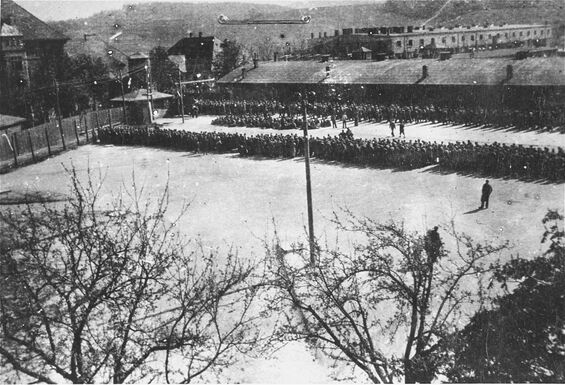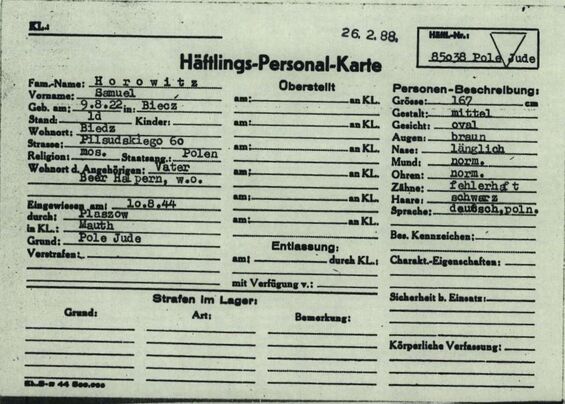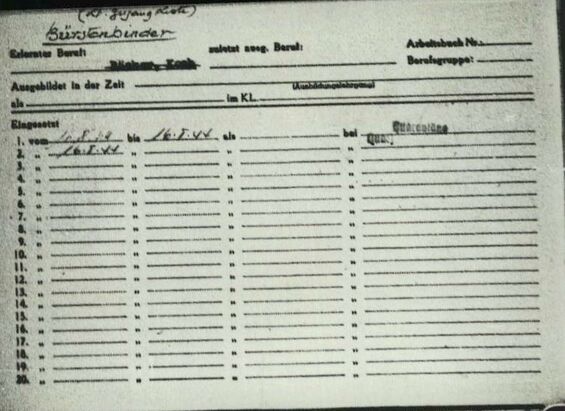The Biography of Samuel Halpern, Biecz
Short biography and stations of his persecution
- born on 9 August 1922 in Biecz/Poland
- September 1939 to July 1942 forced labour Biecz, Biecz ghetto
- July 1942 to autumn 1943 Krakow-Plaszow Jewish camp,
- six months Krakow ghetto,
- 1944 Krakow-Plaszow concentration camp
- 10 August 1944 for a few weeks in Mauthausen concentration camp, prisoner number 85038,
- August or September 1944 - March 1945 Mauthausen concentration camp/Melk subcamp,
- March 1945 - 6 May 1945 Mauthausen concentration camp/Ebensee subcamp
- 3 July 1945 Haifa/Israel
He was 17 years old when his persecution began.
Before the War
I, Samuel Halpern (Horowitz) born 9 August 1922 in Biecz/Poland, now residing at 688 Lafferte Ave, Broklyn, N. Y., lived in Biecz at the outbreak of the war. My father Mr Halpern was born on 10.9.1888 in Rzeszow and was chief rabbi of Biecz and surroundings and his files are in Trier.
Source: Affidavit 1963
September 1939 to 22. July 1942 Biecz/Biecz ghetto
When the German troops marched in in September 1939, I was dragged off with all the other Jews for forced labour. Every day until mid-1941 I did forced labour in Biecz under the strictest guard. I worked for the German Wehrmacht under the command of Lieutenant Hasenei and Major Schoerner. I worked for the Kirchhof and Emil Ludwig companies in road construction and for the Backer and Ullrich company, which was a sand and pebble factory. I brought the pebbles from Biecz to the Krosno airport construction site.
Source: Affidavit of Samuel Halpern
At the beginning of the German-Polish war we both lived in Biecz, Jaslow district, neighbouring the district of Rzeszow (Reichshof) in Poland. The Jewish badges were introduced in our district on 20 October 1939.
I, Samuel Halpern, remember the date so well because we were gathered in the village of Olpin to take part in a memorial service in our rabbinical school. While we were gathered there for this purpose, a neighbour came with the afternoon newspaper in which it was announced that all Jews in the Reichshof, Jaslow, Neu-Sanders and Korsno districts would have to start wearing the Stars of David on 20 October at 12 o'clock at night and that they would never be allowed to appear on the street without this star. Threats of punishment were attached to this. The man who had a say in these matters from the German side in Neu-Sanders at the time was a certain Hamman; the district captain in Jaslow was a certain Dr Gaenz. I remember the date and the incident exactly. That was a very drastic measure at the time, a harbinger of coming disaster. There was great excitement at the time and I am therefore absolutely certain of the incident and the date. I was at that time of year with our father.
Source: affidavit of Chaskel Halpern, born 26.1.1919 in Biecz, Poland and Samuel Halpern, born 9.8.1922 in Biecz, Poland. New York 15.10.1956, , Compensation file Samuel Halpern, LANDESAMT FÜR FINANZEN, Amt für Wiedergutmachung, Rhineland-Palatinate
note: „In the summer of 1940, the Judenrat had to supply 30 Jews per day for German forces stationed in the area. Some Jews worked in the Ulrich-Becker sand and gravel plant, where meager wages were paid, and others on water regulation projects." Source: [1]
July 1942 to Autumn 1943 Plaszow forced labour camp
Afterwards I was deported from Biecz to Krakow/Plaschow, where I worked for Siemens & Halske and several other building and civil engineering companies. I was beaten and abused a lot, I was always hungry and had no proper clothing. I also worked for a Regensburg company called Klug.
Note: "The action of the ghetto’s annihilation started on the 22nd of July 1942. All the men between 18 and 35 years old were gathered in the market square. 170 people were directed to work camps in Karków-Płaszów.".Source: [2]
.
| Location | Kraków-Plaszów / Kraków-Plaszow |
| Name | "Julag I" |
| Territory | General Government, Krakow District (1939-1944) |
| Opening | June 1941 (first mention) |
| Closing | Autumn 1943 |
| Gender | Men |
| Employment of the prisoners at | Siemens Bau-Union company; Mayreder & Kraus, Vienna; Klug company; Müller-Preudheim company; Rheinische Hoch- und Tiefbaugesellschaft, Mannheim |
| Type of work | Barrack construction, road construction |
| Remarks | The prisoners were assigned to the forced labour camp for Jews in Krakow-Plaszow, Jerozolimska Street at an unspecified time |
| Source: deutschland-ein-denkmal.de | |
Herbst 1943 - August 1944 Ghetto Krakau/KZ Plaszow
Dann arbeitete ich 6 Monate im Ghetto Krakau und Spaeter kam ich ins Konzentrationslager Krakau/Plassow. Dort habe ich verschiedene schwere Arbeiten geleistet, ich litt an Hunger und mangelnder Bekleidung, ich wurde schikaniert und von den Aufsehern geschlagen.
Anmerkung: Die Zeit in Krakau/Plaszow wird in einer kurzen Biografie des Vaters wie folgt beschrieben: "In Krakow, the Halpern family stayed alternately in the ghetto and in Julag II in Prokocim, working in the ‘commandos’ producing brooms and brushes and working in the kitchen, laundry room, and bakery." Quelle: [3]. Das KZ Krakau-Plaszow wurde im Januar 1944 eröffnet.
10 August 1944 - 6 May 1945 Mauthausen, Melk and Ebensee
In August 1944 I was transported from Krakow/Plassow to Mauthausen. I was travelling for about 8 days, all the Jews were crammed into cattle wagons. We were 100 prisoners in a small cattle wagon. During the whole journey we were given nothing to eat, nothing to drink, no water to wash with, it was just terrible. I spent a few weeks in the Mauthausen concentration camp. From there I was deported to Melk/Austria.
Where I worked underground building shafts. I was once hit over the head with a rifle butt there. Since then, I have had hearing problems in my left ear. In March 1945, I was taken from Melk to Linz on a steamer that was normally used to transport livestock. From Linz we went to Ebensee, and we walked and it took about 8 days. At night we slept on the wet grass and during the day we, as weakened people, had to walk and we were only given something to eat once every three days.
In Ebensee we were deployed in a quarry, where a large piece of stone fell on my head in April. I fell over immediately and when I came to, I was in the sick bay with my head stitched up and bandaged. Since then I have suffered from constant headaches, dizzy spells and insomnia. I also have anxiety attacks and bad dreams.
Samuel Goldstoff (witness)
The witness Samuel Goldstoff, born on 21 September 1916 in Krakow, was with Samuel Halpern throughout the period of persecution. He declared in a statutory declaration dated 5 March 1950 before the Restitution Department of the Central Committee of Liberated Jews in the U.S. zone of Germany, Munich:
At the outbreak of war on 1 September 1939, I was living at al. Jozefinska 3, Krakow. In March 1941, a ghetto was set up in Krakow and my apartment remained in the ghetto. I lived in the ghetto until March 1943. In March 1943, I was deported from Krakow to the Plaszow concentration camp Plaszow concentration camp and was there until August 1944. I first worked building barracks and then processing paper. In August 1944, I was deported to the Mauthausen concentration camp and was in quarantine there for 10 days. After 10 days, I was taken to the Melk subcamp and was there until April 1945. I worked there for the Gross German Schachtbau company. On 13 April 1945 I was loaded onto a tugboat and after four days I arrived in Linz and from there I was taken by foot to the Ebensee sub-camp. I was there until 6 May 1945 and was liberated by the American troops on that day.
On 3 May, I had an accident while working in Ebensee. A narrow-gauge railway train ran over both my legs, as a result of which my right lower leg had to be amputated.
Source: Samuel Goldstoff file, Landesamt für Finanzen, Landesentschädigungsamt, Az. EG 2052
Samuel Goldstoff, born 21 September 2016 Krakow/Poland, 3/1941-3/1943 Krakow Ghetto (A: military supply unit), 3/1943-8/1944 Plaszow concentration camp (A: barracks construction, paper processing), 10.8.1944-5/1945 Mauthausen #84840, Melk (A: Fa. Gross deutscher Schachtbau), Ebensee, 27.7.1946 Munich, 1950 USA
After Liberation
Notes
Further Sources
- Encyclopedia of CAMPS AND GHETTOS, 1933–1945, VOLUME II, Ghettos in German-Occupied Eastern Europe, Part A, S. 483
- sztetl.org.pl: Biecz, siehe auch Encyclopedia of CAMPS AND GHETTOS, 1933–1945, VOLUME II, Ghettos in German-Occupied Eastern Europe, Part A, S. 483: „At the end of July, the Germans summoned all male Jews aged 18 to 35 to the market square and selected about 170 for work in the Płaszów forced labor camp. Among this group were most of the few survivors from the Biecz ghetto.“
- see Biografie Beer Halpern
- see Häftlingspersonalkarte
- see above
- File of Samuel Goldstoff, Bavarian State Compensation Office, ref. EG 2052
Office for Compensation
Trier, Az.: VA 75 509
Notes
last changed 1/23/2025: missing part of Samuel Halpern's affidavit added, Samuel Goldstoff's description of his persecution added.
Picture Credits
- Quelle:Photo-Nummer 02009, United States Holocaust Memorial Museum, courtesy of National Archives and Records Administration, College Park
- Quelle:Individuelle Häftlings Unterlagen - KL Mauthausen 1.1.26.3/1493786/ITS Digital Archives, Arolsen Archives
- Quelle:Individuelle Häftlings Unterlagen - KL Mauthausen 1.1.26.3/1493786/ITS Digital Archives, Arolsen Archives



